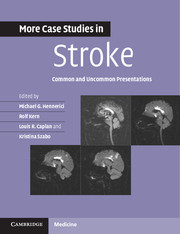101 results
Section 1 - Common cases of stroke
-
- Book:
- More Case Studies in Stroke
- Published online:
- 05 June 2014
- Print publication:
- 15 May 2014, pp 11-38
-
- Chapter
- Export citation

More Case Studies in Stroke
- Common and Uncommon Presentations
-
- Published online:
- 05 June 2014
- Print publication:
- 15 May 2014
Index
-
- Book:
- More Case Studies in Stroke
- Published online:
- 05 June 2014
- Print publication:
- 15 May 2014, pp 169-172
-
- Chapter
- Export citation
List of contributors
-
-
- Book:
- More Case Studies in Stroke
- Published online:
- 05 June 2014
- Print publication:
- 15 May 2014, pp ix-xii
-
- Chapter
- Export citation
More Case Studies in Stroke - Title page
-
-
- Book:
- More Case Studies in Stroke
- Published online:
- 05 June 2014
- Print publication:
- 15 May 2014, pp iii-iii
-
- Chapter
- Export citation
Introduction:approach to the patient
-
- Book:
- More Case Studies in Stroke
- Published online:
- 05 June 2014
- Print publication:
- 15 May 2014, pp 1-10
-
- Chapter
- Export citation
Abbreviations
-
- Book:
- More Case Studies in Stroke
- Published online:
- 05 June 2014
- Print publication:
- 15 May 2014, pp xiv-xvi
-
- Chapter
- Export citation
Contents
-
- Book:
- More Case Studies in Stroke
- Published online:
- 05 June 2014
- Print publication:
- 15 May 2014, pp v-viii
-
- Chapter
- Export citation
Section 3 - Stroke mimics
-
- Book:
- More Case Studies in Stroke
- Published online:
- 05 June 2014
- Print publication:
- 15 May 2014, pp 141-168
-
- Chapter
- Export citation
Copyright page
-
- Book:
- More Case Studies in Stroke
- Published online:
- 05 June 2014
- Print publication:
- 15 May 2014, pp iv-iv
-
- Chapter
- Export citation
Section 2 - Uncommon cases of stroke
-
- Book:
- More Case Studies in Stroke
- Published online:
- 05 June 2014
- Print publication:
- 15 May 2014, pp 39-140
-
- Chapter
- Export citation
More Case Studies in Stroke - Half title page
-
- Book:
- More Case Studies in Stroke
- Published online:
- 05 June 2014
- Print publication:
- 15 May 2014, pp i-ii
-
- Chapter
- Export citation
Preface
-
-
- Book:
- More Case Studies in Stroke
- Published online:
- 05 June 2014
- Print publication:
- 15 May 2014, pp xiii-xiii
-
- Chapter
- Export citation
Chapter 20 - Motor, stance, and balance consequences of cerebral small vessel disease
- from Section 3 - Clinical aspects of cerebral small vessel disease
-
-
- Book:
- Cerebral Small Vessel Disease
- Published online:
- 05 June 2014
- Print publication:
- 01 May 2014, pp 251-260
-
- Chapter
- Export citation
Contributors
-
-
- Book:
- Cerebral Small Vessel Disease
- Published online:
- 05 June 2014
- Print publication:
- 01 May 2014, pp ix-xii
-
- Chapter
- Export citation
Case 30 - Young mother found comatose on the bathroom floor
- from Part II - Uncommon cases of stroke
-
- Book:
- Case Studies in Stroke
- Published online:
- 23 November 2009
- Print publication:
- 30 November 2006, pp 133-136
-
- Chapter
- Export citation
Case 29 - Isolated difficulty, writing and grasping
- from Part II - Uncommon cases of stroke
-
- Book:
- Case Studies in Stroke
- Published online:
- 23 November 2009
- Print publication:
- 30 November 2006, pp 130-132
-
- Chapter
- Export citation
Case 49 - Woman with right arm discomfort and sudden blindness
- from Part II - Uncommon cases of stroke
-
- Book:
- Case Studies in Stroke
- Published online:
- 23 November 2009
- Print publication:
- 30 November 2006, pp 210-213
-
- Chapter
- Export citation
Index
-
- Book:
- Case Studies in Stroke
- Published online:
- 23 November 2009
- Print publication:
- 30 November 2006, pp 259-272
-
- Chapter
- Export citation
Case 23 - “My arm no longer belongs to me…”
- from Part II - Uncommon cases of stroke
-
- Book:
- Case Studies in Stroke
- Published online:
- 23 November 2009
- Print publication:
- 30 November 2006, pp 106-110
-
- Chapter
- Export citation

